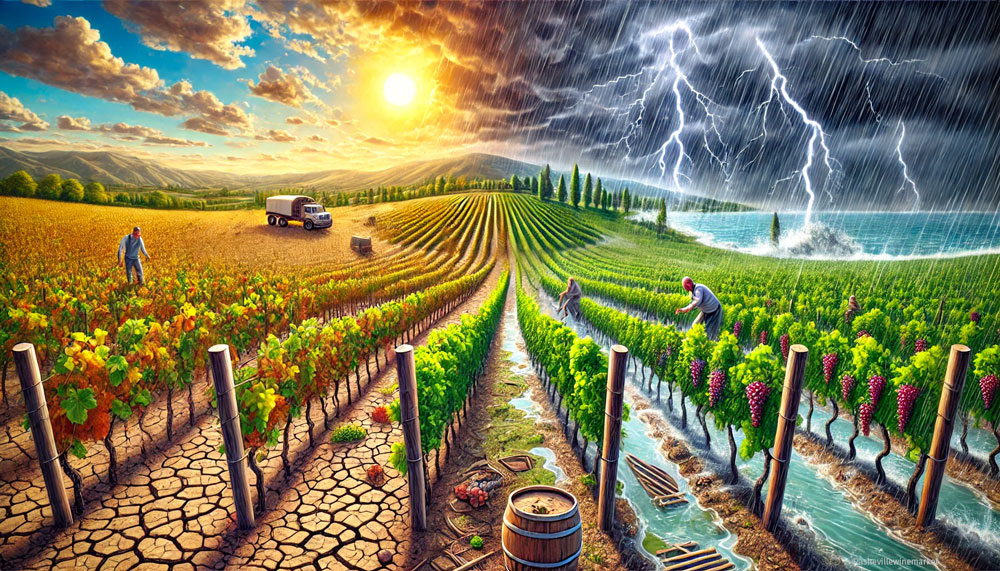
Have you noticed that your favorite wine seems a bit different and doesn’t taste the same as it used to — even though it’s the same label you’ve enjoyed for years? Perhaps you’ve revisited a rock-solid, reliable white or red, only to discover it’s no longer a favorite. You might assume your taste buds are wonky, you may suspect there’s something off with the vintage (certainly not out of the realm of possibilities, but unlikely as an AWM customer), or you may think your tastes have changed. I submit to you that it may be none of the above — your favorite red or white simply may be a casualty of climate change.
Global warming has become an undeniable force reshaping life worldwide, and vignerons haven’t dodged the climate change bullet. Sadly, rising temperatures, wildly shifting weather patterns, and increased frequency of extreme climatic events are altering places where grapes have flourished for countless generations. The consequences of climate change extend beyond vignerons to wine lovers, who increasingly notice changes in the cost, style, and even the quality of their favorite wines.
Ask any vigneron, and they’ll tell you that climate change is disrupting age-old traditional winemaking practices. In France, warmer temperatures are speeding up grape ripening, leading to higher sugar levels and increased alcohol content in the finished wines. Without a doubt, this significantly affects the nuanced aroma and flavor profiles we all love in French wines.
Italian vignerons are also facing unpredictable weather, dealing with increasing numbers of unexpected frosts and heatwaves, wreaking havoc on harvest yield and quality. Traditionally hot and dry, Spain is encountering the worst hot and dry they’ve ever experienced, with severe droughts that terribly stress the vines while significantly reducing yields.
Over the last few decades, climate change has definitely made its mark on the wine world. Wines have become more robust in style and alcohol content due to higher sugar concentrations in grapes from warmer growing seasons. While some wine lovers may applaud and appreciate the bolder flavors and higher octane, others miss the subtlety and lower alcohol levels of traditional vintages. Harvest times are moving earlier in the year, and some warmer climates are harvesting at the end of August! This throws a huge wrench into a winery’s labor dynamics and makes it a nightmare in planning for grape pickers.
Looking to the future, winemakers are adapting in various ways. In response to rising temperatures, some vignerons are experimenting with grape varietals that are more heat-resistant or have longer growing seasons. In my last couple of visits to Bordeaux, I’ve noticed a significant uptick in the planting of Malbec — a terrific choice for heat-challenged terroir.
Vignerons in the most aggressively climate-challenged areas are working overtime to modify vineyard practices. Many are changing and adjusting canopy management to protect grapes from excessive sun exposure. Others are implementing advanced irrigation systems to combat drought. On a recent buying trip to Burgundy, I noticed that many vignerons were installing mechanized hail nets to prevent irreversible damage to the vines.
A notable trend I never thought I’d see is the quiet migration toward cooler climate areas. Vignerons from regions with thousands of years of viticultural heritage are exploring higher altitudes or more northerly latitudes to establish new vineyards. French Champagne producers are investing in vineyards on the west coast of England. Britain’s cooler climate was once wholly unsuitable for quality wine production; however, it’s now becoming the perfect place for producing very Champagne-like bubbly. This geographical shift could redefine traditional wine maps and introduce new regional players in the wine industry.
The future of wine in a warming climate is indeed an odd blend of onerous challenges and exciting opportunities. As climate shifts, advancements in viticulture and evolving styles and tastes will all work to reshape the global wine landscape.
The good news is that the wines will continue to evolve as well. Count on the traditional wine-growing areas to continue experimenting with different grape varieties and techniques, while regions previously considered unsuitable for viticulture will continue to improve their wine production prowess.
